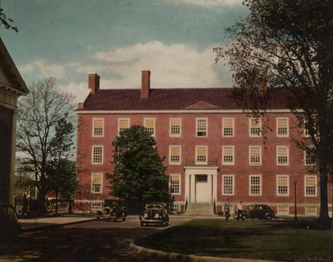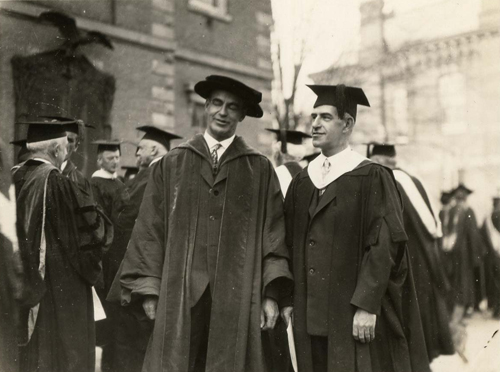In this picture we see the brothers Hopkins, both presidents of small liberal arts colleges. On the right is Louis Bertram Hopkins, the seventh president of Wabash. On the left is Ernest Martin Hopkins president of Dartmouth College. This photograph was taken at the inauguration of Louis at Wabash.
It has always interested me that these two brothers served at these two institutions at the same time. The connections between Dartmouth and Wabash are numerous…if we start at the beginning of Wabash, we must start with Edmund O. Hovey. A graduate of Dartmouth, Hovey attended the seminary and then came west to begin his life’s work. Present at the founding, Hovey put his life into Wabash by raising the money to open and then support this struggling little college on the frontier. He also taught at Wabash, housed students, served as secretary and treasurer. Hovey gave his life to Wabash.
Another Dartmouth man from our early history is Caleb Mills, a name well-known on campus. Mills graduated Dartmouth, attended seminary and applied for the position of first member of the faculty. Mills and Hovey had known each other back east, both at college and at Andover Seminary. Mills, like Hovey, was inspired to come to the west to bring education and religion to the people of the Wabash Country.
In another Dartmouth connection, our former president Thad Seymour was Dean of the College at Dartmouth when he accepted the presidency of Wabash College.
Back to the brothers Hopkins…Aside from some photos of the brothers at the inauguration, we have a more permanent link with Dartmouth, the architect Jens Frederick Larson. 
Larson was the College Architect at Dartmouth and also designed our Chapel and Goodrich Hall. These two buildings sit side by side and form the southwest corner of our mall. They are, to my mind, the two handsomest building on campus.
This is a photograph of Hopkins’ inauguration in the Wabash gymnasium. While it is difficult to see at this size and resolution, the speaker at the podium is Ernest Hopkins who, we can assume, took a great deal of pride in speaking at his brother’s inauguration.
While the Hopkins presidency at Wabash was often fractious, it is widely accepted that the unpopular changes made were key to our later success. The reformation of the curriculum, the creation of the divisional system, senior comprehensive examinations, entrance standards and having more control over athletics were all changes implemented during President Hopkins’ tenure at Wabash.
While many alums bemoaned the death of Old Wabash, the faculty largely supported these changes. It was a hard presidency for Hopkins as Byron Trippet writes in his memoir, Wabash on My Mind, yet it created the Wabash of the 20th century. Our president Hopkins died in 1941, but his brother lived on until 1965. An interesting pair and one of many fascinating connections between our two schools.
Best,
Beth Swift


4 comments on “The brothers Hopkins”
And my dad was teaching at Dartmouth when he came to Wabash to work with Dr. Brigance!
Karen,
How could I have forgotten that?
Vic Powell came to Wabash from Dartmouth in 1947 to teach for one year under W. Norwood Brigance. More than 60 years later, Vic and his bride are still here at Wabash.
Beth
When I left Dartmouth to come to Wabash, a faculty friend told me that Caleb Mills had preached at the Congregational church in Hopkinton, NH, when he was back for his 50th college reunion, when Dartmouth awarded him an honorary degree. In the congregation that Sunday was the Hopkins family, and the two sons, Ernest and Louis, heard Caleb Mills preach. Another link between two great institutions.
By the way, Edmund O, Hovey’s father was the blacksmith who did most of the iron work for the original Dartmouth Hall, the main classroom building.
Thad Seymour
Excellent additions!
Beth
Another personal connection.
Jens Frederick Larsen (his friends called him “Fritz”) had an office in Hanover, NH, for many years, and one of his apprentices was a young man named Stanley Orcutt. Stan was the volunteer organist in the Congregational church which we attended there, and when we were leaving for Indiana he said, “Give my regards to my chapel.” He explained that his first job with Larsen was working on the Wabash Chapel, and he was particularly proud of the urns he designed for its steeple. I often would look at those urns and think good thoughts of our old Dartmouth friend, Stan Orcutt.
Comments are closed.